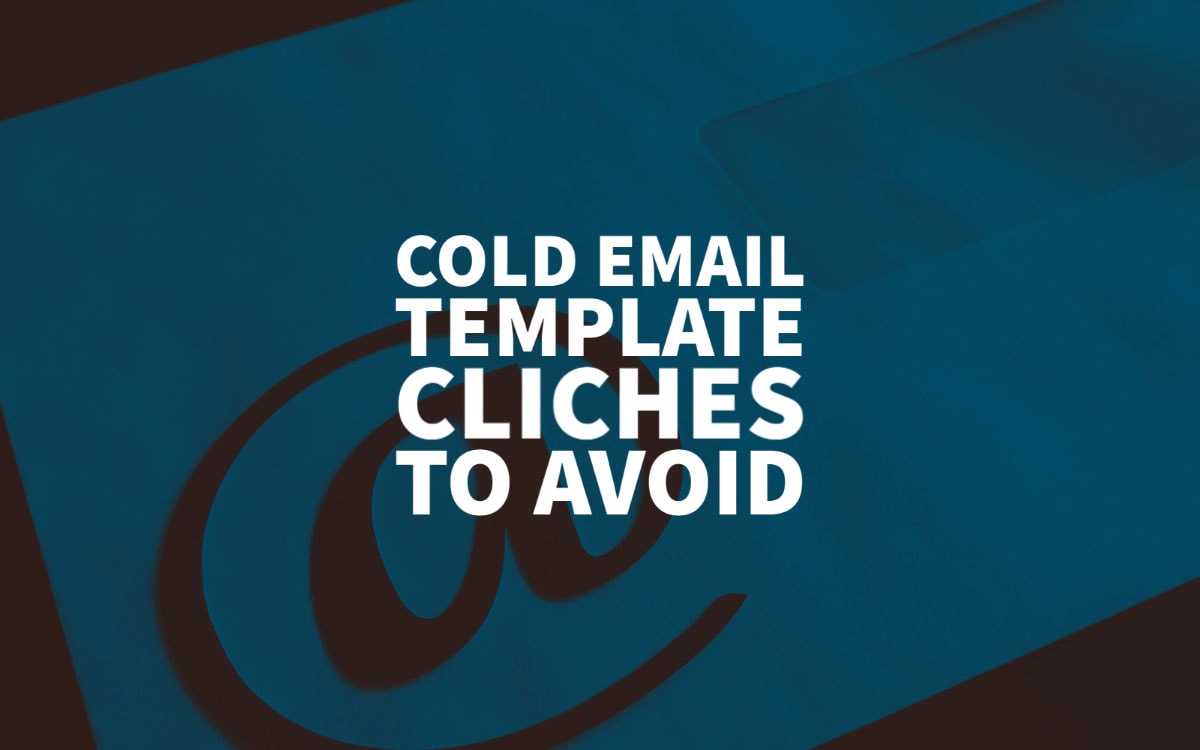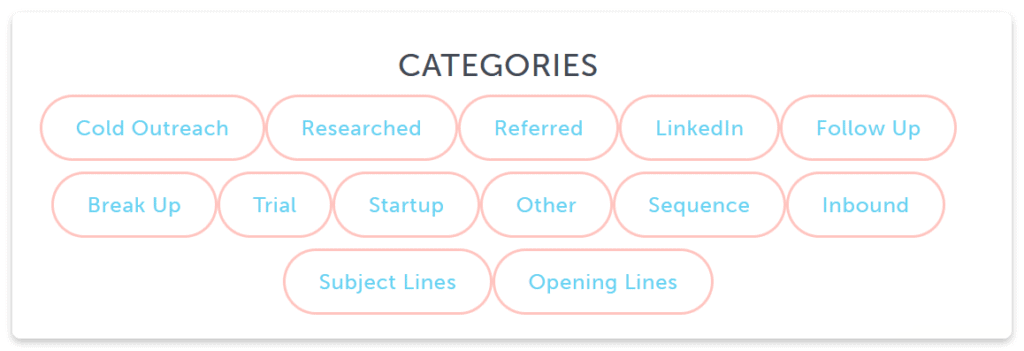
20 Nov Cold Email Template Clichés To Avoid
Cold Email Template Clichés To Avoid
Cold emailing might appear like a bad rap for many entrepreneurs.
Mostly, it is a result of various poorly implemented email marketing campaigns.
But it is still a tool every entrepreneur should consider as long as it is effectively used.
For cold emailing to be effective, a connection with your leads must be established, which implies that using the hard sell approach will not be ideal.
People are already bombarded with numerous sales emails.
This is why it is better to use attention-grabbing strategies to build the relationship needed for your brand.
Fortunately, to make things easier for you, most cold outreach automation platforms like Snov.io are equipped with useful features that can be used for different campaign objectives.
One of such feature is templates. Let’s dive into their peculiarities.
Pros and cons of using cold email templates
Although some email marketers prefer to create their email templates to suit their marketing objectives, the majority of cold email automation tools offer ready-made email templates.
Using them in your cold email marketing campaign comes with both benefits and drawbacks.
Benefits
Less productivity cost
The costs that are usually accumulated when developing an email campaign can become significant if care is not taken.
From email design, writeup, and review – this process will not be cheap.
However, cold email templates can help cut the cost of your email campaigns.
A large variety to choose from
Most email automation platforms offer thousands of email libraries with custom email templates that can be selected by marketers for different email campaign objectives.
Onboarding, re-engagement, follow-ups – they’ve got you covered.
Follow up with “GIFs” or even “Memes” just make sure you don’t offend anyone.” Capitalize on the P.S. “This is my favourite. – Pipedrive

Template types for different objectives (Source: Cirrus Insight)
No need to involve more people
Email templates simplify the management of messages, which helps avoid any form of stress.
Very few individuals can easily handle their simplicity without involving an entire marketing team.
Faster turnaround time
The process involved in creating emails alongside edits, finalising, and testing can take several hours.
But ready-made templates can help reduce turnaround time.
Drawbacks
No unique brand identity
Ready to use templates commonly use a design offered by email automation platforms.
Other companies might send similar campaigns, which will make your business no different from them.
As a result, you will lack the brand image and identity that usually make it easier for customers to differentiate between companies.
Limited customisation personalisation
Such email templates give room for less personalisation, as most formats have been pre-designed.
Emails can look generic
Another major drawback of using cold email templates is the similarities of each email sent, which will make them appear generic.
Cold email template clichés to avoid
Undoubtedly, email templates offer many benefits, ranging from faster turnaround time to low cost and reduced workforce.
However, to ensure better results, it is necessary to get rid of the following clichés while crafting your cold email drip campaign:
Don’t use spam words
The easiest method of ensuring that your messages safely arrive in your recipient’s inbox is to avoid words that can trigger spam filters.
They can be categorised as:
● Manipulative phrases and words that create a sense of urgency, such as “apply now,” “click here,” “exclusive deals,” “get started now,” and so on.
● Cheap phrases and words that don’t bring any value to your offer, such as “cheap,” “congratulations,” “free info,” “giving away”, etc.
● Unrealistic phrases or words, such as “billion dollars,” “double your income,” “fantastic deal,” and others.
● Pushy phrases and words, such as “do it today,” “unlimited,” “order now,” etc.
● Desperate phrases and words, such as “100%,” “gift,” “satisfaction guaranteed,” and so on.
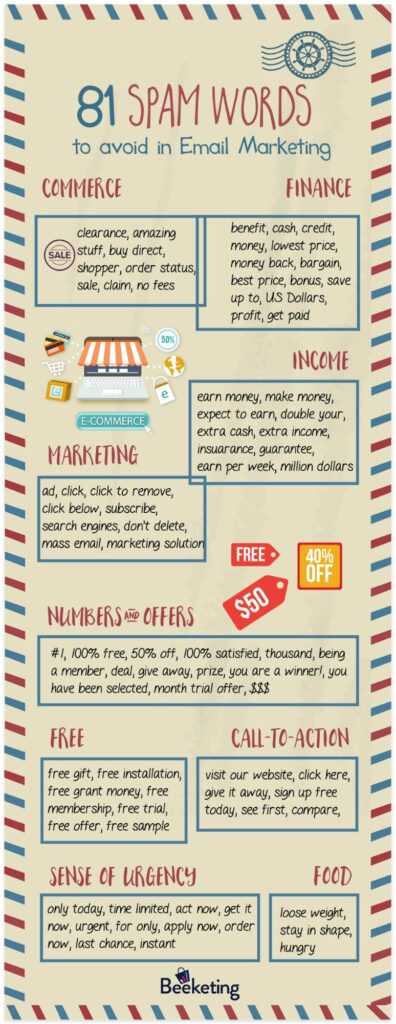
Source: Beeketing
Instead of adding spam-triggering phrases, you can experiment with both your email subject line and email body in several ways.
Use emojis, make jokes and puns and include power words that will spark your readers’ curiosity.
It is also essential to implement personalisation in subject lines and ensure the effectiveness of personalisation tags.
Don’t overuse “I,” “we,” or “us”
First, overusing personal pronouns such as “we,” “I,” and “us” can lead to more confusion, as it might make your recipients lose track of whom you are referring to in your message.
But what is even more critical, you shouldn’t be narcissistic in your email, or else your leads might not read any further.
Introduce Yourself Properly – The whole concept of cold emailing means that your recipients don’t know who you are. – Semrush
Instead of devoting a whole paragraph to yourself and your company, replace every “I” with “you” and focus on your recipient and their needs.
Some examples of self-serving phrases you should avoid are:
● “My name is …”
● “Let me introduce myself”
● “My company specialises in …”
This template below can serve as an example of how not to do it.
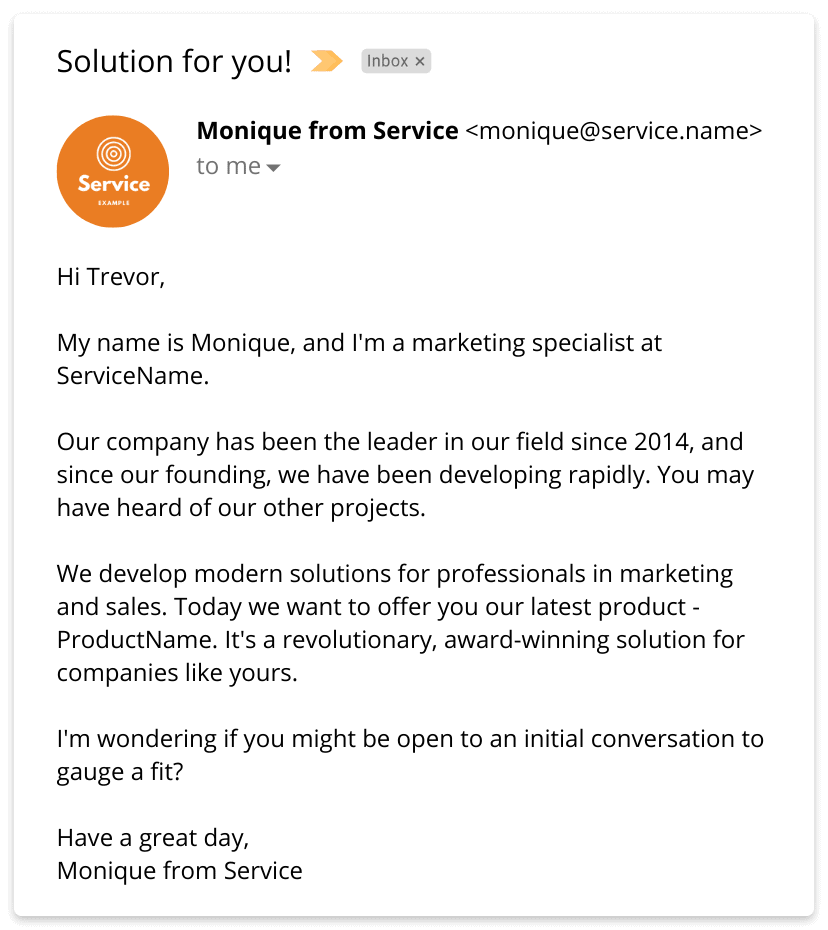
Your lead does not know you yet, and focusing on yourself will not help you convert them.
Get rid of the boring intro
The introduction of your email is a crucial aspect where you can make your messages more interesting and capture your leads’ attention.
But when sending multiple letters, there is a possibility that you might want to opt for the default method of communication.
Instead of looking for the next cold email template to copy/paste, you need to learn the fundamentals and create your own cold email templates that are specifically tailored to your target audience. – Sales Hacker
It might be tempting to have the same introduction every time but remember that changing things up in your messages can help grab more attraction.
For example, the “Hello [Name]” method of greeting is standard.
Try alternative options like saying “Hi”, “Good morning,” or merely starting the email with only the name.
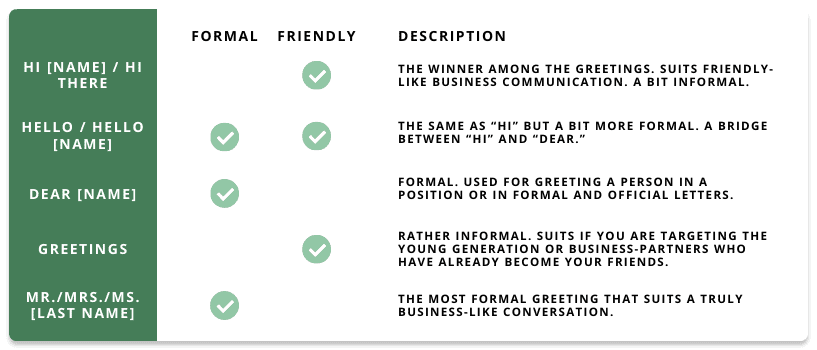
Email greetings examples
Besides, there is absolutely nothing wrong with getting straight down to business.
Or you can ask a simple, excellent question to spark their curiosity or mention your previous email, as it will help your introduction flow correctly into other parts of your message.
Don’t use generic one-liners
Most email senders use generic one-liners at the beginning to appear more polite.
For instance, “I hope this email finds you well,” “Hope you are well,” and so on.
Nowadays, such phrases might be considered insincere since you’re probably sending hundreds of similar messages to numerous prospects.
Don’t forget, the primary objective of cold emailing is to create value, which is lacking in this type of opening.
Subject lines are therefore the gateway to your cold email’s success.” – Richard Roma, Sales Manager at ONBOARD.
An alternative method is to substitute it with something that can grab the attention of your recipient.
It’s better to personalise openers, e.g., “The first half of 2020 was particularly challenging for [Industry Name], but I hope you made the most of it.”
Additionally, always check to see areas that can be reduced in your email.
Keeping things short will increase the chances that your recipient will read your messages till the end.
Avoid selling phrases
The last thing your recipients want after opening your email is to get bored because of generic sales pitches or phrases.
Different words trigger different behaviours in individuals.
Some words can make them lower their guards, while others can make your audiences go on the defensive, which is why you need to choose your words carefully.
Phrases like “I can offer”, “I have a great solution”, or “Check out the details” will undoubtedly create resistance in your audiences.
As we’ve mentioned earlier, your email should be about your recipients and their needs and wants, not about you.
Make an educated guess about one pain point and offer a tactical suggestion for it.
With that in mind, structure your cold sales email in a way that clearly and concisely communicates the following: The value you add The offer you’re making The proof that supports it The action you want the prospect to take If your emails are running too long, here’s what to watch out for: Muddying details and irrelevant information Boasting or making claims that aren’t ground in fact Asking the prospect to do too many things (“A confused mind says no.”) A caveat: There’s not a hard word or character count that makes for a successful sales email. – Hubspot
Don’t jump to arranging a quick call
I’m aware that you have an urge to drive your audience to your call-to-action button, but it is more critical to initially help your clients develop a positive relationship with your brand.
Start a conversation first by asking relevant questions that spark interest.
When you feel your leads are engaged enough, then that’s time to schedule a call.
Follow-ups are a great time to go for a bigger ask such as hopping on a call. Perhaps one benefit didn’t resonate from the first email, so use your follow-ups as a chance to highlight other benefits. – Leadfuze
Get rid of “Looking forward to”
“Looking forward to” is a familiar friendly sign-off option, but its popularity can make it become overlooked by most recipients.
Depending on the context, it might also seem relatively passive and sometimes considered as “Thank you in advance.”
Besides, such phrases are fillers that take away your readers’ time.
There are several alternatives to using “Looking forward to:”
● Call-to-action phrases like “Would you please let me know by October 28 if you’ll be able to attend?”
● Appreciative phrases like “I’m grateful for your help”
● Short but up-to-the point sign-off phrases like “Take care,” “All best,” or “Thanks.”
Here are some more alternatives:
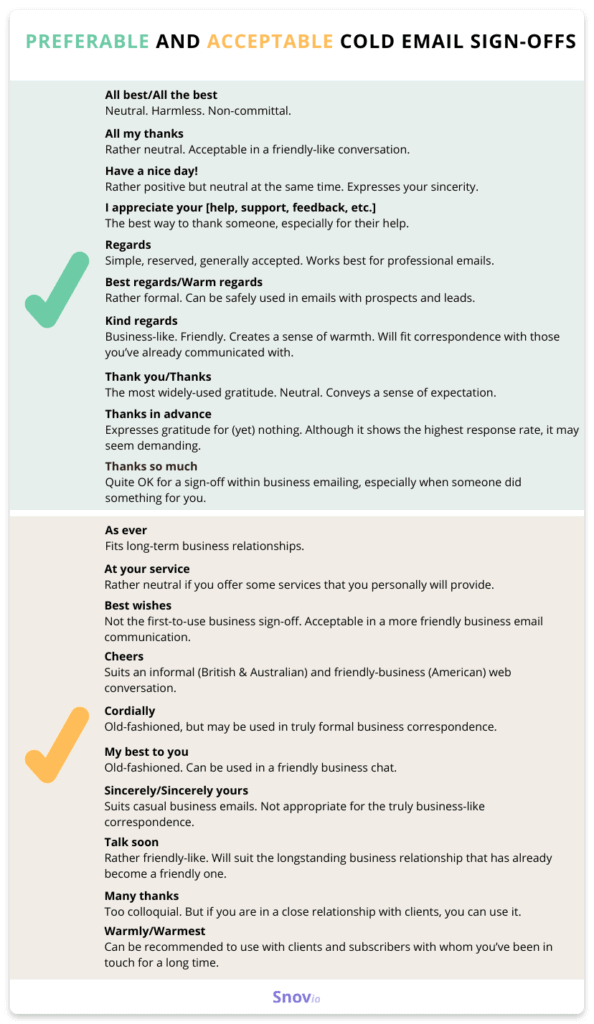
Alternative email sign-offs
Don’t say you are sorry
You might want to say something along the lines of “Sorry to bother you” to sound considerate and polite.
But using such phrases can make you look cheap and undermine your credibility.
Let’s be honest: you probably wouldn’t reply to an email like this:
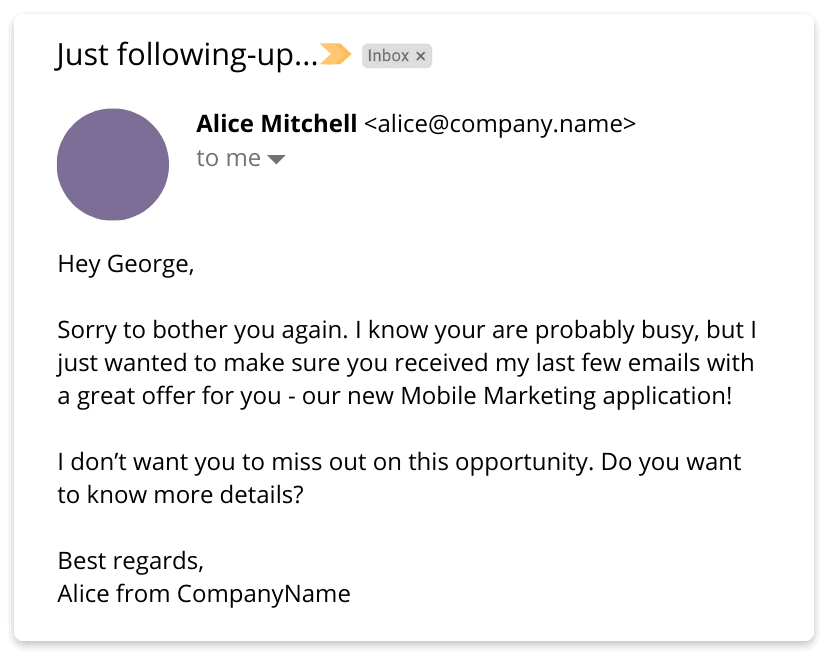
The best option is to go straight to the point and inform your recipient about what to expect in your email.
State the purpose of contacting them and tell them what you want them to do.
Another situation when you feel you want to apologise is when you reply to a message late.
But even then, it’s better not to draw attention to your mistake. Instead, say “Thank you for your patience.”
Wrapping it up
On average, it takes your recipients 11 seconds to read an email.
Therefore, if you want to guarantee that your letters are read, it is recommended to be direct and straight to the point.
Most importantly, avoid spam-triggering phrases and clichés like “I hope this email finds you well,” Don’t hesitate to contact me,” and so on.
Just keep in mind that your email doesn’t need to be a masterpiece; it only needs to meet its objective.
There are a number of reasons people send cold emails; here are some of the most common reasons: Link building outreach (including guest posting, resource link building, and digital PR) Sales prospecting Influencer marketing Seeking mentoring Asking a favour from someone (appearing on your podcast, sharing tips for your round-up, etc.) The most important thing to grasp when running a cold email campaign is how to do it, rather than why. – Semrush
And if you are looking for more tips on how to improve your email marketing, check out our blog post on top email marketing mistakes to avoid.
Author Bio: Tamara Zhostka is the chief editor at Snov.io, who is working her finger to the bone to make sure you get the freshest insights from the marketing world. She is always happy to share valuable tips with marketers and entrepreneurs.
